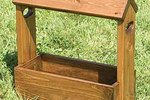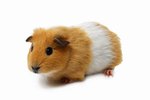
The best way to lure robins to add to the chorus of songbirds in your yard is by serving up a spread of their favorite treats. Usually robins prefer foraging for their food, but when you provide a smorgasbord of mealworms, chopped apples and pears and assorted berries such as cranberries, blueberries and blackberries, you won't be able to keep them away. A special platform feeder is an effective way to display a robin-friendly feast. It's a simple open-front box with a top that protects the food from the elements while still allowing your feathered friends to enjoy the fare.
Step 1
Mark off the feeder pieces on the red cedar using the tape measure and pencil. The back piece should be 9 1/4 inches by 13 inches, the floor should be 8 inches by 7 inches, the top should be 8 inches by 8 1/2 inches and the two sides should be 8 inches by 6 inches each.
Step 2
Cut the pieces from the red cedar with the saw, using the pencil marks as guidelines.
Step 3
Make a shallow notch in one of the 8-inch sides of each side piece. Start by measuring a half-way point along the edge of one of the 8-inch sides on both side pieces and marking them with your pencil. From that point, measure in 1 1/2 inches and make another pencil mark. Then draw a line from the two corners of that same side to the second pencil mark you made. This will create a wide, shallow "V" that you can cut out using the saw. Remember to do this with both side pieces.
Step 4
Measure 2 inches in from the end of the back piece. Do this along one of the 13-inch ends, placing a pencil mark on each side, then drawing a straight line between them. This will be the guideline for placing your top piece.
Step 5
Apply the wood glue to one of the 8-inch edges of the top piece and glue it to the back piece using your pencil guideline to place it. The back piece is wider than the top piece, so you'll need to center the top piece on the back. You can use the tape measure to do this if you want to, but it's not necessary.
Step 6
Secure the top piece in place by pounding nails through the back piece into the edge of the top piece. Place nails so that there is one at either end of the top piece and then one in the middle.
Step 7
Spread wood glue to the un-notched 8-inch edges of the side pieces and along the top edge. Put them in place under the top piece, butting the top edges of the side pieces up against the bottom of the top piece. The outer sides of the side pieces should be flush with the top piece so that the walls of the feeder run in a smooth line from the roof on down.
Step 8
Insert nails to secure the side pieces to the back piece, nailing one nail at the top of each side piece, one at the bottom of each side piece and one nail into the middle of each side piece so that there are three nails total holding each side piece in place.
Step 9
Apply wood glue to the bottom edge of each side piece as well as one of the 8-inch edges of the floor piece.
Step 10
Put the floor piece into place under the side pieces, pressing the glued edge of the floor piece to the back piece.
Step 11
Secure the bottom piece to the back piece with the nails, placing them so that there is one at either end of the bottom piece and one in the middle for a total of three nails.
Step 12
Insert nails into the top piece and down into the side pieces to further secure the pieces together. You only need to place one in each back corner and then one more at the point approximately at the middle of the side pieces.
Step 13
Pound nails through the bottom piece of the feeder up into the side pieces, placing them as you did through the top: one at each back corner and one more at the middle point of the sides.
References
- Washington State University Cooperative Extension: Encouraging Songbirds in Your Backyard
- Mother Earth News: The Bird Feeder's Handbook, Plus Build Your Own Platform Feeder
- Learner.org: Robin Platform Feeder
- Oregon State University Extension Service: How to Help Robins Through the Winter in Your Yard and Garden
- Robins: Songbirds of Spring; Mia Posada
- Best-Ever Backyard Birding Tips; Deborah L. Martin
Tips
- Some lumber yards will cut your red cedar into the correct size of pieces for you, allowing you to eliminate the measuring and cutting steps from this process.
- Let the glue set for one or two minutes before attempting to nail the pieces of your feeder into place. It doesn't need to dry entirely, but it should be set up enough to hold the pieces in place while you hammer the nails in.
- You can either hang your platform feeder from a tree branch or nail it to a post or a tree, pounding two, 3-inch nails through the back of the feeder into the post. You can also mount it on the top of a post if you prefer.
Photo Credits
-
Jupiterimages/Photos.com/Getty Images
Writer Bio
Elle Di Jensen has been a writer and editor since 1990. She began working in the fitness industry in 1987, and her experience includes editing and publishing a workout manual. She has an extended family of pets, including special needs animals. Jensen attended Idaho and Boise State Universities. Her work has appeared in various print and online publications.




